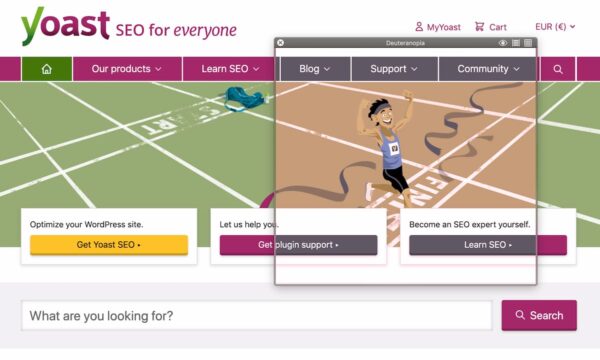One of our core philosophies is keeping you and your site up to date with the latest changes in Google’s inner workings and policies. These last couple of weeks saw an interesting new development, with Google rewriting many titles in the SERPs. In Yoast SEO 17.1, we are making a couple of small changes that help you write great titles that stand up to Google’s scrutiny. Another cool thing is a product-specific SEO and readability analysis in WooCommerce SEO 14.4.
Yoast SEO 17.1: Keeping up with changes in search and SERPs
For years, Google has been changing stuff in the search engines results pages if it thinks it can write a better description of your content. Now, Google started to rewrite titles much more aggressively, and the results vary. Still, millions of homepages out there have a page title of ‘Home’ or a contact form that says ‘Contact’ and that’s not good enough. Google does great work writing proper titles for pages like these.
In Yoast SEO, we offer tools to help you write a great page title (the ) as well as an SEO title (the ). We even have an assessment that checks if your title contains your focus keyphrase and whatnot. In addition, the assessment checks whether your title fits within a certain range — if it’s too short, you’ll get a red bullet. In Yoast SEO 17.1, we’re changing the title assessment.
Google changes titles, we change the title assessment
In Yoast SEO 17.1, we still check your titles, but we won’t penalize you if it’s too short. Shorter titles are theoretically less likely to be changed by Google, as they’re more precise and concise. They’re more focused and contain fewer superlatives, for instance. We’re not saying that you should write shorter titles, though, but we’re giving you the option.
As of today, we give you more control over your titles — whether they are short or long. Although, we’re not changing the upper limits yet. Of course, we can’t control what Google does with — or to? — your title, so it’s up to you to write a title that clearly describes the page in the best possible way.
If you are worried about how your titles might look you need to analyze the changes in the SERPs. You don’t have to check every page you have, but you need to check up on your most important ones. Search Google to see how they appear and if Google rewrote stuff. Check your analytics to see if there was a drop in CTR to those pages. And, of course, keep crafting remarkable page titles that stand the test of time — and that Google recognizes as such.
The second change is in the title separators. We’ve removed the | and ~ from the title separator settings because Google seems to change these to — in the SERP titles actively. If you want, you can pick another separator.
While we were at it, we also ensured that our Google Preview closely mimics the latest visuals in the search results. This gives you the most up-to-date view of how your post might look in Google — barring Google’s rewriting efforts, of course.
More enhancements in Yoast SEO 17.1
Yoast SEO 17.1 comes with more enhancements, of course. We’ve improved the filtering of function words in Dutch, English, Indonesian, Russian, and Spanish on the language front by including time-related words like ‘minute.’
Looking at performance optimizations, we have made the process of saving posts faster by excluding unchanged items. This is very noticeable on posts with many links. Finally, we now no longer show the SEO Optimization notification on non-production sites, as this is not very useful in that situation.
WooCommerce SEO 14.4: an analysis focussed on products
Today, our WooCommerce SEO plugin also gets a big upgrade. In WooCommerce 14.4, we’ve updated the SEO and readability analysis making it product-specific. We’ve added a couple of new checks, changed the ranges of several of the existing ones, and made sure that they all made sense to use on product pages.
For instance, there’s a new list check to see if you’ve used a list on your product pages — as lists are essential tools to convey information about your products. We’ve updated the images check to see if you’ve added enough images and videos, while also checking if they have proper alt text. Many ranges of the checks have changed as well, so you don’t need to write 900 words for your product pages to have a green bullet. These are just a couple of the changes in WooCommerce 14.4.
Read up on all the cool new stuff in WooCommerce SEO 14.4 and use it to make the best possible product pages out there!

Improving your product descriptions in WooCommerce SEO
Update now!
Yoast SEO 17.1 is out today. In this release, we fine-tuned some things based on a couple of recent changes at Google. We’ve also worked on the performance, and we’ve added a couple of language enhancements. If that’s not all, we gave our WooCommerce SEO plugin an updated, product-specific version of the analyses to help you build better product pages.
The post Yoast SEO 17.1: an update on page titles appeared first on Yoast.
Did you miss our previous article…
https://www.dentaltourisminromania.com/?p=187


